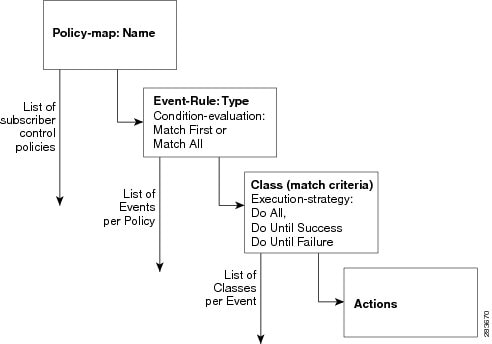Control Policy Overview
A control policy enables the service provider to define actions that must be performed during various subscriber lifecycle events, such as creation of a session, connectivity loss, and so on. For the complete list of events, see Control Policy Events.
Different actions can be executed for different subscribers based on various match criteria. Some actions that can be specified in the control policy are:
-
Authenticating or authorizing a subscriber by an external AAA server
-
Starting subscriber accounting
-
Activating specific configurations on the subscriber using dynamic templates
A control policy is deployed using policy-map and class-map. Each policy-map contains a list of events that the service provider considers applicable to the subscriber lifecycle. The policy-map also defines the actions that will be performed during these events. However, these actions are performed only when certain conditions are met. These conditions are called match criteria. The match criteria are defined in class-maps, which is included within the policy-map. It is possible to have different match criteria for different subscribers.
For example, a control policy can be created to start the "subscriber authentication" action, when a "session start" event occurs, for a specific "MAC address" match criteria. After this control policy is deployed, when the device having the specified MAC address starts a new session, BNG initiates the subscriber authentication process.
The actions defined in the policy-map are executed by action handlers. For more information about supported action handlers, see Action Handlers.
The following figure shows the structure of control policy. It illustrates that for each policy there can be multiple events; for each event, there can be multiple classes; and for each class, there can be multiple actions. As a result, a single policy map can be used to trigger multiple actions, when a match is found for a single or several criteria, during one or many events.

policy-map type control subscriber policy-map-name
event <event-type> [match-all|match-first]
class type control subscriber <class-map-name>
<seq#> <action-type> <action_options>
 Note |
From Cisco IOS XR Software Release 5.2.2 and later, you can edit the class associated with the subscriber policy even while the sessions are active. Prior to this, new class map actions were not editable if the sessions were up, and any such dynamic policy-map changes resulted in clearing off the subscriber sessions. |
 Note |
Limit the |
 Feedback
Feedback